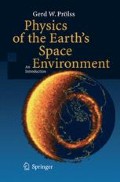Abstract
The term geospheric storm is used here to designate an event of strongly enhanced dissipation of solar wind energy in the near-Earth space environment. Such activities typically last for 1 to 3 days and are characterized by energy dissipation rates of up to 1012W. This is many times greater than the usual energy transfer rate from solar wind to magnetosphere.
Access this chapter
Tax calculation will be finalised at checkout
Purchases are for personal use only
Preview
Unable to display preview. Download preview PDF.
References
A. P. Mitra, Ionospheric Effects of Solar Flares, Reidel Publishing Company, Dordrecht, 1974
S.-L Akasofu, Physics of Magnetospheric Substorms, Reidel Publishing Company, Dordrecht, 1977
J.T. Gosling, The solar flare myth,J. Geophys. Res., 98, 18937, 1993
R.D. Elphinstone, J.S. Murphree, and L.L. Cogger, What is a global auroral substorm. Rev. Geophys., 34, 169, 1996
G.W. Prölss, Magnetic storm associated perturbations of the upper atmosphere, in Magnetic Storms (B.T. Tsurutani, W.D. Gonzalez, Y. Kamide, J.K. Arballo, eds.), AGU Monograph No. 98, 227, Washington, 1997
B. T. Tsurutani, W.D. Gonzalez, Y. Kamide, and J.K. Arballo (eds.), Magnetic Storms, American Geophysical Union, Washington, 1997
A. Ieda, S. Machida, T. Mukai, Y. Saito, T. Yamamoto, A. Nishida, T. Terasawa, and S. Kokubun, Statistical analysis of the plasmoid evolution with GEOTAIL observations, J. Geophys. Res., 103, 4453, 1998
S. Kokubun and Y. Kamide (eds.), Substorms-4, Kluwer Academic Publishers, Dordrecht, 1998
A. Hanslmeier, The Sun and Space Weather, Kluwer Academic Publishers, Dordrecht, 2002
Author information
Authors and Affiliations
Rights and permissions
Copyright information
© 2004 Springer-Verlag Berlin Heidelberg
About this chapter
Cite this chapter
Prölss, G.W. (2004). Geospheric Storms. In: Physics of the Earth’s Space Environment. Springer, Berlin, Heidelberg. https://doi.org/10.1007/978-3-642-97123-5_8
Download citation
DOI: https://doi.org/10.1007/978-3-642-97123-5_8
Publisher Name: Springer, Berlin, Heidelberg
Print ISBN: 978-3-642-05979-7
Online ISBN: 978-3-642-97123-5
eBook Packages: Springer Book Archive

